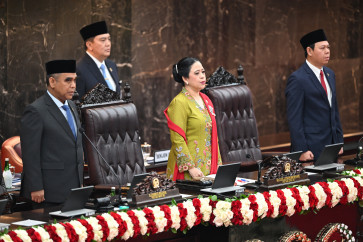Popular Reads
Top Results
Can't find what you're looking for?
View all search resultsPopular Reads
Top Results
Can't find what you're looking for?
View all search resultsSuicide among the poor
On Aug
Change text size
Gift Premium Articles
to Anyone
O
n Aug. 13, 2010, The Jakarta Post printed a story about Khoir Umi Latifah, a 25-year old woman who committed suicide and murdered her two sons by setting herself and her children on fire in Sleman regency, Yogyakarta – a tragedy allegedly resulting from depression caused by financial hardship.
Umi worked as a housekeeper at a boarding house where she occupied a room with her husband, 30-year old Slamet Yahya, and her two sons, Muhammad Lindu Aji, 4, and two-and-half year old Muhammad Dwi Arya Saputra.
According to the report, the incident took place while Umi’s husband was not at home. She locked herself in a bathroom and poured gasoline over herself and her sons before igniting the fatal blaze.
A boarding house resident was unable to immediately assist them because of the locked door.
When the door was finally opened, Umi was found dead with severe burns all over her body. Her sons were rushed to the hospital but could not be saved. The youngest boy passed away first while the older son perished three hours later.
Sadly, this is not the only case of poverty leading to suicide in Indonesia. In the last few months the mass media has reported several similar cases of poor people committing suicide because of financial difficulties.
According to the World Health Organization, the average annual rate of deaths by suicide in Indonesia is 24 per 100,000 people, many of which are attributed to poverty and homelessness.
Most people agree that suicide is a psychological phenomenon. Nonetheless, if suicidal tendencies are higher among a particular group of people — such as the poor — then suicide is not merely psychological, it is a sociological phenomenon as well.
Sociologist Emile Durkheim stated that the causes of suicide are often external rather than internal (Kenneth Thompson, 1992, Readings from Emile Durkheim).
Based on Durkheim’s sociological perspective, there are three types of suicide; egoistic, altruistic and anomic suicide.
Egoistic suicide is attributed to a person’s inability to see any reason to continue living. It is the result of excessive “egoistic” individualism, where the individual ego asserts itself immoderately at the expense the social ego.
Altruistic suicide stems from the conceptualization that the decision to end life is beyond life itself.
There are cases where persons kill themselves not because they believe it is their right to do so, but on the contrary, because it is their “duty”.
This type of suicide explains cases in ancient times when women committed suicide by jumping onto their husbands funeral pyre, symbolizing a woman’s total devotion to her husband.
In fact, not all women committed this act voluntarily, but many had little faith in their future because they believed that there was no longer a place for them in society. So, frankly speaking, it was social pressure that actually killed them.
Anomic suicide relates to unbearable external pressures such as economic crisis, marital problems and academic or professional. On other hand, in some cases prosperity has also been blamed for suicide.
In Durkheim’s words “Every disturbance of equilibrium, even though it may involve greater comfort and raising a general pace of life, provides an impulse to voluntary death”.
The economically driven suicide committed by Umi, and many others, falls under the category of anomic suicide, though they could also be related to the egoistic classification, as the two are closely linked.
This tragedy further demonstrates that the burden of poverty has reached alarming levels. For some people poverty becomes so unbearable it convinces them end their life.
Clearly suicide is often related to social problems such as poverty and injustice, but gender inequality can also be another factor. I did not find statistics on the number of men and women who have committed suicide because of poverty. However from media reports I have observed that women are more likely to commit suicide than men, and like Umi, are more likely to intentionally kill their children before killing themselves.
This could relate to cultural norms, and patriarchal norms in particular, which assign women – regardless their working status – responsibility for most domestic responsibilities, including managing household financial matters.
Women are also responsible for ensuring that food is always on the family table, regardless of economic circumstances. For some poor women these responsibilities lead to depression, and sometimes suicide.
At a macro level this is an indication that the government has failed to completely provide for the basic needs of its people, especially the poor.
The cases of suicide among the poor also mirrors the complexity of poverty. Poverty is more than just numbers. It is a human tragedy.
The writer is a lecturer at Parahyangan Catholic University’s School of Social and Political Sciences in Bandung.










